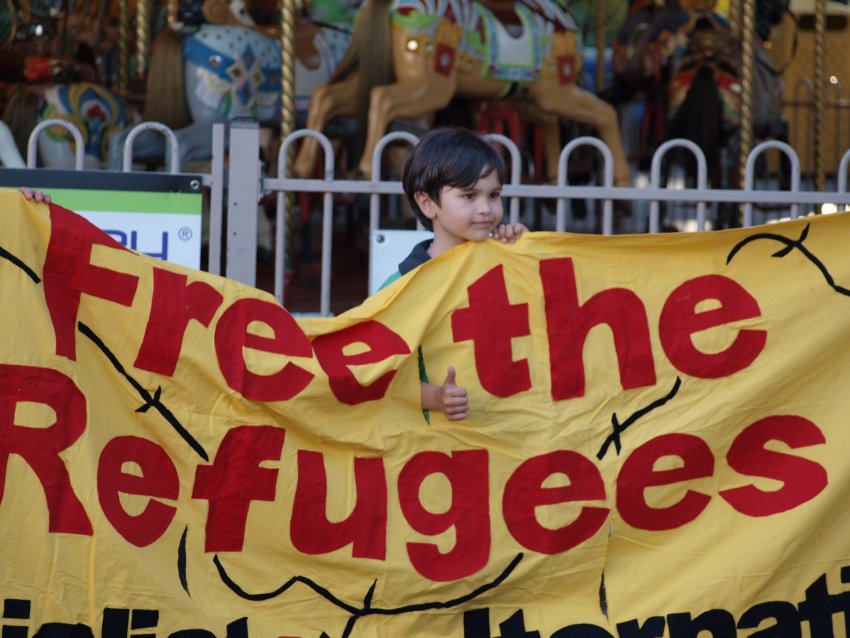
The federal Labor government has announced plans to move some children and families out of refugee detention, but will not change its policy of locking up unaccompanied children who arrive in Australia by boat.
The October 18 announcement followed a concerted campaign by refugee advocacy groups to end mandatory detention and a Greens bill to release all 738 children presently in detention.
Three years after promising to end the mandatory detention of children, the government pledged to move “the majority” of children into alternative “freer” community housing, and without permanent protection visas being granted, and not until July 2011.
At the same time, it announced two new refugee detention facilities — at Northam near Perth and Inverbrackie near Adelaide — to lock up another 1900 refugees and “relieve the current pressures” on the refugee detention system.
It would also expand current facilities in Perth, Darwin and Melbourne.
An October 18 immigration department statement said the Northam site would be built to detain up to 1500 adult men. The government told a Senate estimates hearing it would cost more than $164 million, reported ABC News on October 20.
The Inverbrackie facility would be built at an old defence housing barracks to hold 400 people at a cost of $9.7 million. It would include the construction of a fence around the entire complex, with plans to post guards at the gates.
The plans have been criticised by refugee advocacy groups, immigration and refugee lawyers, and human rights organisations. The Asylum Seeker Resource Centre (ASRC) said building new detention centres undermines the government’s claim to treat asylum seekers “humanely”.
The policy of mandatory detention of children remains. The immigration department said a refugee determined to be eligible under the government's plans, whether a child or adult, “remains in immigration detention but is accommodated in the community”.
Immigration minister Chris Bowen said he was aware that indefinite detention was detrimental to children and people who have experienced torture or trauma. He said priority would be given to vulnerable families, those at risk of mental health problems, and pregnant women.
But the government won’t take steps to end indefinite detention, instead choosing to discuss “long-term detention values”.
All new arrivals will continue to be detained and the government has refused to provide any legal protection to limit how long children can be detained.
Children who have not passed “security checks” would still be locked up indefinitely. There are 382 people under 18 being held in detention centres who arrived unaccompanied by a parent or guardian.
The alternative “community” detention is not much more humane. The government sets up remote facilities, such as that in Leonora in WA, or in often hostile communities — the Woodside facility in Inverbrackie has already generated a racist backlash.
Guards will be posted to stop refugees from “absconding” and, while children will be able to attend school, they will be accompanied by guards.
Asylum Seeker Resource Centre CEO Kon Karapanagiotidis said the government’s policy moves were “merely a band–aid, similar to what the Howard Government did four years ago to take community pressure off actually changing the law to end the mandatory detention of children”.
He called for a change of law. The refugee rights movement has demanded an end to mandatory detention, a practice that is illegal under international law.
Mandatory detention did not exist in Australia until 1992, when the Keating-Labor government began locking up refugees arriving by sea. Before that, community centres — including the building that has become the Villawood detention centre — provided open accommodation and support services to new asylum seekers and refugees that had received visas.
The new detention policy was expanded and made even more cruel under the then Liberal/National Coalition PM John Howard. A strong refugee rights movement in the early part of this century forced back many of Howard’s more horrific practices, such as the “Pacific Solution” and imprisoning refugees for up to 10 years.
In 2007, Labor promised to release children from detention and hold asylum seekers for no more than three months — both promises yet to be carried out.
But recent government decisions have exacerbated conditions to inhumane levels. This includes the visa processing freezes, as well as much longer processing periods and ASIO “security checks”, which has meant some asylum seekers have been locked up for up to 12 months or more.
More than 5000 people — who have fled danger and persecution — are being held behind razor wire in Australia, this includes the 738 people under 18 and 319 women. The Australian government cannot claim to be “compassionate” to traumatised children and families and in the same breath announce the expansion of mainland detention.
The negative effects of detention have been proven time and again. What’s more, it is illegal to lock up an innocent person under any circumstance — much less those who come here seeking protection and safety.
The government might hope its announcement about changing the detention arrangements for some children might relieve pressure from refugee advocates and activists. But we must continue to build the campaign to free all refugees and end mandatory detention, for good.